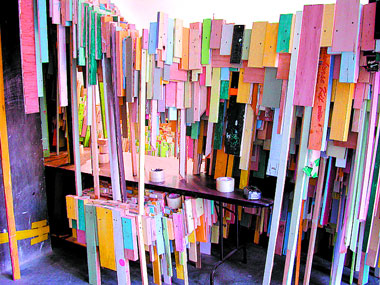Phoebe Washburn creates an installation both smart and spontaneous
To peer into the LFL Gallery from 24th Street, you might think it is a construction site. There are 2 x 4’s jutting down to the floor, holding up a precarious arching wooden structure in the way that a flying buttress supports a cathedral. Even with the threat of danger, our curiosity beckons us to wind our way deeper inside the gallery.
Like a Giacometti standing figure renewing itself around every turn, Phoebe Washburn’s installation opens up and dazzles us, even taking us by surprise. Through a rambling terrain of color and a wave of rhythmic geometry, our eyes dance, discovering a wacky landscape made from painted wood fragments that create a modern topography of wonder.
In the tradition of Gaudi, Smithson and Serra, Washburn brings her world to life, transforming the gallery into a massive monumental construction. By changing our sense of scale with the repetitive use of multicolored joined strips of wood, Washburn made me feel as though I were flying into Rio de Janeiro, where buildings and apartments are stacked one on top of another, creating a steep Cubist mountain slope.
Sawdust, pencils, thumbtacks, and rolls of tape are randomly planted among the wave of brightly colored blocks, leaving clues to the creative process and the magic of transformation. Clearly notions of recycling and environmentalism are being raised, but these issues seem only a footnote to the overall pleasure, strength and gestalt of the experience. I hope that intellectual pressure won’t hold Washburn back, but that instead she continues pushing her visual strengths over the top, creating some truly bizarre and inspired spectacles.
With strong formal concerns, heroic scale and obsessive desire, Washburn has managed to create an installation strong both visually and conceptually. By remaining playful, lyrical and intuitive, she avoids the pitfalls of dry heavy-handed “installation” art so common today, and demonstrates that art can still be smart, spontaneous and visually satisfying.



































